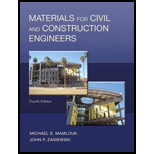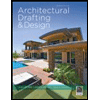
Pearson eText for Materials for Civil and Construction Engineers -- Instant Access (Pearson+)
4th Edition
ISBN: 9780137505586
Author: Michael Mamlouk, John Zaniewski
Publisher: PEARSON+
expand_more
expand_more
format_list_bulleted
Question
Chapter 10, Problem 10.15QP
To determine
Write about five different imperfections found in the lumber.
Expert Solution & Answer
Want to see the full answer?
Check out a sample textbook solution
Students have asked these similar questions
P
What's the stress increase, DUZ (induced stress) at point p
according to the chart shown? Show work and mark the
chart to demonstrate how you came up with an answer
36ff
Qis
24f+
P (at depth 12ft)
Point R is below Q, which is on the edge of the footing.
24 ft from one corner (thus 12 from the other). Show
how to divide the area into two and use the principle of
Super position to calculate stress increase (DJ₂) aka
induced stress at R. Draw a plan view of Area I and
Arca 2. Find L1, B₁, and 2, dimensions and indicate them
accordingly on both Area 1 and Area 2
24f1
-
24ft
•R (depth 12ft)
. For the cast-iron piping shown in Fig. 4, calculate the flow rate if H = 8 m. (e=0.26
mm, v=1.0×10m²/s)
Include all losses.)
2 m
Water
H
20°C
20 m
40 m
T
2 cm dia.
4 cm dia.
Angle valve
(wide open) (4.7)'
A5.2- A simply supported beam with the given cross-section, as shown in Figure 2, is subjected to
factored uniform load of 50 kN/m. The designer would like to cut-off 2-30M bars where they are no
longer required by the design.
Determine the cut-off point for 2-30M bars according to CSA 23.3 requirements.
Given: Concrete: Normal density with f'c = 30 MPa
Reinforcement: Uncoated rebars with fy = 400 MPa
Shear reinforcement is in excess of CSA 23.3 minimum requirement: 10M
Clear cover to the stirrups: 40 mm
Columns: 500 mm x 500 mm
9 m
W= 50 kN/m
Figure 2
h=600 mm
b=500 mm
Cross-section
As = 5-30M
Chapter 10 Solutions
Pearson eText for Materials for Civil and Construction Engineers -- Instant Access (Pearson+)
Ch. 10 - What are the two main classes of wood? What is the...Ch. 10 - Prob. 10.2QPCh. 10 - Prob. 10.3QPCh. 10 - Discuss the anisotropic nature of wood. How does...Ch. 10 - Prob. 10.5QPCh. 10 - Prob. 10.6QPCh. 10 - Prob. 10.7QPCh. 10 - Prob. 10.8QPCh. 10 - Prob. 10.9QPCh. 10 - Prob. 10.10QP
Ch. 10 - Prob. 10.11QPCh. 10 - Prob. 10.12QPCh. 10 - Prob. 10.13QPCh. 10 - Prob. 10.14QPCh. 10 - Prob. 10.15QPCh. 10 - Prob. 10.16QPCh. 10 - Prob. 10.17QPCh. 10 - Prob. 10.18QPCh. 10 - Prob. 10.19QPCh. 10 - Prob. 10.20QPCh. 10 - Prob. 10.21QPCh. 10 - Prob. 10.22QPCh. 10 - Prob. 10.23QPCh. 10 - A wood specimen was prepared with actual...Ch. 10 - A pine wood specimen was prepared with actual...Ch. 10 - Prob. 10.26QPCh. 10 - Prob. 10.27QPCh. 10 - Prob. 10.28QPCh. 10 - Prob. 10.29QPCh. 10 - Prob. 10.30QPCh. 10 - Prob. 10.31QPCh. 10 - Prob. 10.32QPCh. 10 - Prob. 10.33QP
Knowledge Booster
Similar questions
- 1. Calculate the ultimate load carrying capacity of the pile tip driven into the soil profile shown below: G.W.T. 45' Qapp Soft Clay: Ysat 100 pcf Cu 500 psf, ou = 0° 平 12' Soil Plug Driven Steel Pipe Pile: Outside Diameter = 2' Inside Diameter = 1'11" Hollow (soil plugged) Note: Pile & soil profile are not drawn to scale Qp = ? Please perform the tip capacity calculation two ways: For the first approach, assume that the total vertical stress at the pile tip is balanced by the weight of the pile. For the second approach, assume that the total vertical stress at the pile tip is not balanced by the weight of the pile (which means you need to include the vertical total stress term). Please compare your answers from these two analyses, examine some of your intermediate-stage calculation results such as the total overburden stress at the pile tip relative to the weight of the pile, and discuss whether or not the commonly used assumption about the total vertical stress at the pile tip is a…arrow_forwardA6.2- Given a simply supported beam with the typical cross-section as shown in the figure below. Assume interior exposure for this beam. The beam properties are summarized below. a) Check if the beam section satisfies the CSA A23.3 cracking control requirements. In your calculations, find f, accurately based on the loading, and compare the results with f = 0.6 fy. b) Find the deflection due to DL+LL at mid-span after 6 years. Given: Concrete: Normal density with f'c = 25 MPa Reinforcement: Uncoated rebars with fy = 400 MPa Shear reinforcement: 10M Maximum aggregate size: 20 mm Clear cover to the stirrup: 30 mm Clear spacing between the bars = 35 mm 35 mm 30 mm m WDL= 20 kN/m WLL= 15 kN/m 抖抖 b=400 mm As = 8-25M Cross-section h=500 mmarrow_forwardA5.1- An unbraced column shown in Figure 1, column A-B with square cross-section is given. The column is subjected to Dead load (unfactored): PDL = 3000 kN, MDL-top = 85 kN.m, MDL-bo = -DL-bottom = 100 kN.m. = Assume the cross-section of column is constant from top to bottom, and all the beams have width = 300 mm and height 350 mm. Using f'c = 25 MPa, fy = 400 MPa, design the column and determine the ties spacing and arrangement. Use 25M or 30M bars for longitudinal reinforcement, and 10M bars for ties. Assume clear cover to be 40mm. The design p has to be between 0.01 and 0.02. Column maximum dimension can be 500mm. т 4.0m 7.0m 5.5m + 6.5m Figure 1 Barrow_forward
- 7.43 Neglecting head losses, determine what horsepower the pump must deliver to produce the flow as shown. Here, the elevations at points A, B, C, and D are 124 ft, 161 ft, 110 ft, and 90 ft, respectively. The nozzle area is 0.10 ft². B Nozzle Water C D Problem 7.43arrow_forwardNOTE: Use areal methods only for V,M,N diagrams(Do NOT use the equations) (also draw the N diagram(s) for the entire structure)arrow_forwardNOTE: Use areal methods only for V,M,N diagrams(Do NOT use the equations) (also draw the N diagram(s) for the entire structure)arrow_forward
- NOTE: Use areal methods only for V,M,N diagrams(Do NOT use the equations) (also draw the N diagram(s) for the entire structure)arrow_forwardNOTE: Use areal methods only for V,M,N diagrams(Do NOT use the equations) (also draw the N diagram(s) for the entire structure)arrow_forwardNOTE: Use areal methods only for V,M,N diagrams(Do NOT use the equations) (also draw the N diagram(s) for the entire structure)arrow_forward
- NOTE: Use areal methods only for V,M,N diagrams(Do NOT use the equations) (also draw the N diagram(s) for the entire structure)arrow_forwardProblem 2: Use the table below to compute the coordinates of the centroid of area shown below. y – 3 in.—|— 4 in. - -3 3 in. 3 in. x Area X X * Area y Y * Area Component (in²) (in) (in³) (in) (in³) Square 1 Rectangle 2 Triangle 3 Rectangle 4 Σarrow_forwardA shallow foundation measuring 1 m × 2 m in plan is to be constructed over a normally consolidated sand layer. Given: D₁ = 1 m, №60 increases with depth, N 60 (in the depth of stress influence) = 11, Estimate the elastic settlement using Burland and Burbidge's method. (Enter your answer to three significant figures.) Se mm and Inet = 138 kN/m².arrow_forward
arrow_back_ios
SEE MORE QUESTIONS
arrow_forward_ios
Recommended textbooks for you
 Construction Materials, Methods and Techniques (M...Civil EngineeringISBN:9781305086272Author:William P. Spence, Eva KultermannPublisher:Cengage Learning
Construction Materials, Methods and Techniques (M...Civil EngineeringISBN:9781305086272Author:William P. Spence, Eva KultermannPublisher:Cengage Learning Materials Science And Engineering PropertiesCivil EngineeringISBN:9781111988609Author:Charles GilmorePublisher:Cengage Learning
Materials Science And Engineering PropertiesCivil EngineeringISBN:9781111988609Author:Charles GilmorePublisher:Cengage Learning Fundamentals Of Construction EstimatingCivil EngineeringISBN:9781337399395Author:Pratt, David J.Publisher:Cengage,
Fundamentals Of Construction EstimatingCivil EngineeringISBN:9781337399395Author:Pratt, David J.Publisher:Cengage, Architectural Drafting and Design (MindTap Course...Civil EngineeringISBN:9781285165738Author:Alan Jefferis, David A. Madsen, David P. MadsenPublisher:Cengage Learning
Architectural Drafting and Design (MindTap Course...Civil EngineeringISBN:9781285165738Author:Alan Jefferis, David A. Madsen, David P. MadsenPublisher:Cengage Learning Engineering Fundamentals: An Introduction to Engi...Civil EngineeringISBN:9781305084766Author:Saeed MoaveniPublisher:Cengage Learning
Engineering Fundamentals: An Introduction to Engi...Civil EngineeringISBN:9781305084766Author:Saeed MoaveniPublisher:Cengage Learning Solid Waste EngineeringCivil EngineeringISBN:9781305635203Author:Worrell, William A.Publisher:Cengage Learning,
Solid Waste EngineeringCivil EngineeringISBN:9781305635203Author:Worrell, William A.Publisher:Cengage Learning,

Construction Materials, Methods and Techniques (M...
Civil Engineering
ISBN:9781305086272
Author:William P. Spence, Eva Kultermann
Publisher:Cengage Learning

Materials Science And Engineering Properties
Civil Engineering
ISBN:9781111988609
Author:Charles Gilmore
Publisher:Cengage Learning

Fundamentals Of Construction Estimating
Civil Engineering
ISBN:9781337399395
Author:Pratt, David J.
Publisher:Cengage,

Architectural Drafting and Design (MindTap Course...
Civil Engineering
ISBN:9781285165738
Author:Alan Jefferis, David A. Madsen, David P. Madsen
Publisher:Cengage Learning

Engineering Fundamentals: An Introduction to Engi...
Civil Engineering
ISBN:9781305084766
Author:Saeed Moaveni
Publisher:Cengage Learning

Solid Waste Engineering
Civil Engineering
ISBN:9781305635203
Author:Worrell, William A.
Publisher:Cengage Learning,